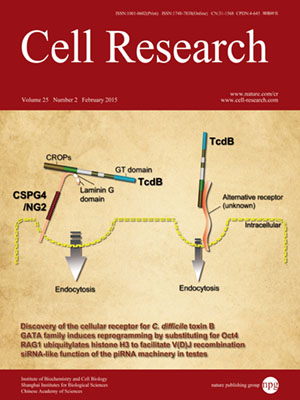
Volume 25, No 2, Feb 2015
ISSN: 1001-0602
EISSN: 1748-7838 2018
impact factor 17.848*
(Clarivate Analytics, 2019)
Volume 25 Issue 2, February 2015: 225-236
ORIGINAL ARTICLES
Tyrosine 370 phosphorylation of ATM positively regulates DNA damage response
Hong-Jen Lee1,5, Li Lan6,7, Guang Peng4, Wei-Chao Chang8,9, Ming-Chuan Hsu1, Ying-Nai Wang1,8, Chien-Chia Cheng1, Leizhen Wei6,7, Satoshi Nakajima6,7, Shih-Shin Chang1,5, Hsin-Wei Liao1,5, Chung-Hsuan Chen9, Martin Lavin10, K Kian Ang2,*, Shiaw-Yih Lin3 and Mien-Chie Hung1,5,8,11
1Department of Molecular and Cellular Oncology, The University of Texas MD Anderson Cancer Center, Houston, TX 77030, USA
2Department of Radiation Oncology, The University of Texas MD Anderson Cancer Center, Houston, TX 77030, USA
3Department of Systems Biology, The University of Texas MD Anderson Cancer Center, Houston, TX 77030, USA
4Department of Clinical Cancer Prevention, The University of Texas MD Anderson Cancer Center, Houston, TX 77030, USA
5The University of Texas Graduate School of Biomedical Science at Houston, Houston, TX 77030, USA
6Department of Microbiology and Molecular Genetics, University of Pittsburgh, Pittsburgh, PA 15213, USA
7Hillman Cancer Center, University of Pittsburgh School of Medicine, Pittsburgh, Pennsylvania 15213, USA
8Graduate Institute of Cancer Biology, Center for Molecular Medicine, China Medical University, Taichung 404
9The Genomics Research Center, Academia Sinica, Taipei 115
10University of Queensland Centre for Clinical Research, Royal Brisbane Hospital Campus, Herston, Australia
11Department of Biotechnology, Asia University, Taichung 404
Correspondence: Mien-Chie Hung,(mhung@mdanderson.org)
Ataxia telangiectasia mutated (ATM) mediates DNA damage response by controling irradiation-induced foci formation, cell cycle checkpoint, and apoptosis. However, how upstream signaling regulates ATM is not completely understood. Here, we show that upon irradiation stimulation, ATM associates with and is phosphorylated by epidermal growth factor receptor (EGFR) at Tyr370 (Y370) at the site of DNA double-strand breaks. Depletion of endogenous EGFR impairs ATM-mediated foci formation, homologous recombination, and DNA repair. Moreover, pretreatment with an EGFR kinase inhibitor, gefitinib, blocks EGFR and ATM association, hinders CHK2 activation and subsequent foci formation, and increases radiosensitivity. Thus, we reveal a critical mechanism by which EGFR directly regulates ATM activation in DNA damage response, and our results suggest that the status of ATM Y370 phosphorylation has the potential to serve as a biomarker to stratify patients for either radiotherapy alone or in combination with EGFR inhibition.
10.1038/cr.2015.8
FULL TEXT | PDF
Browse 2095


